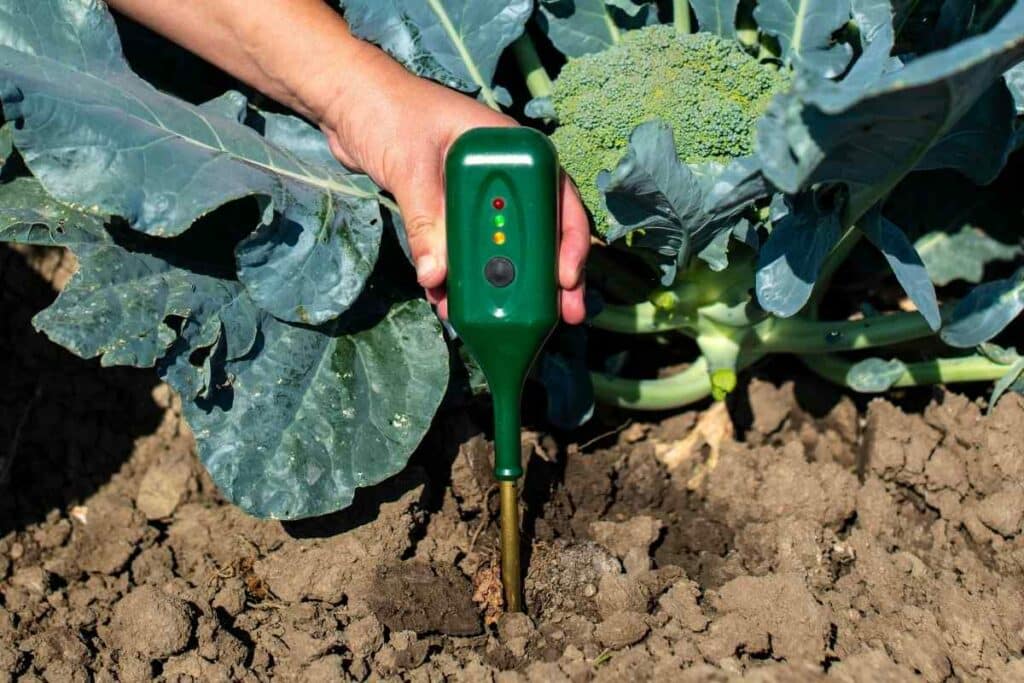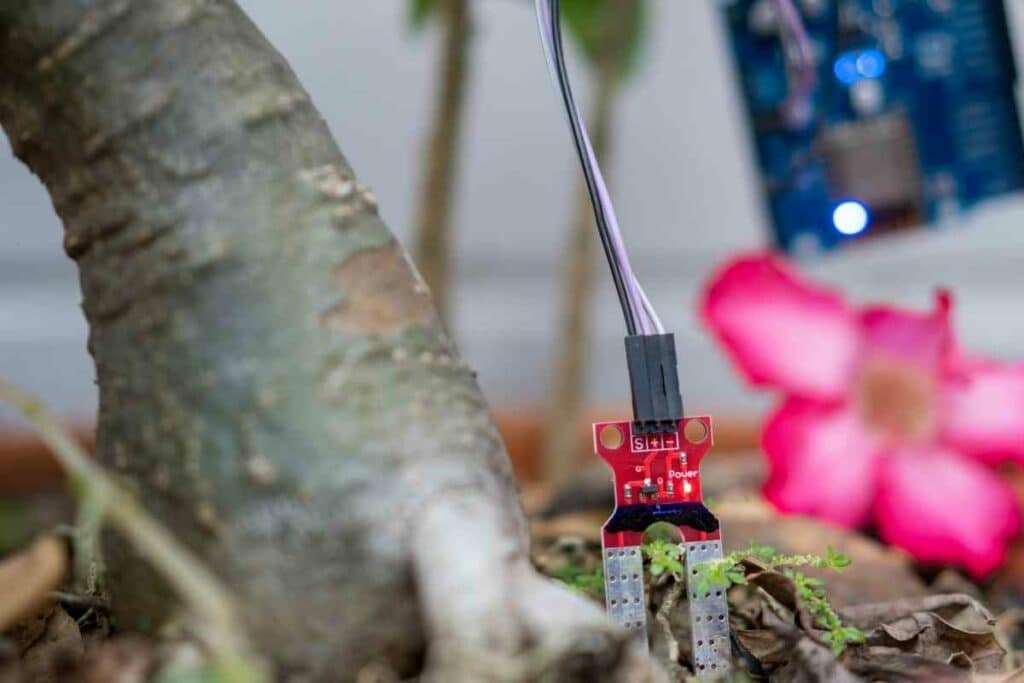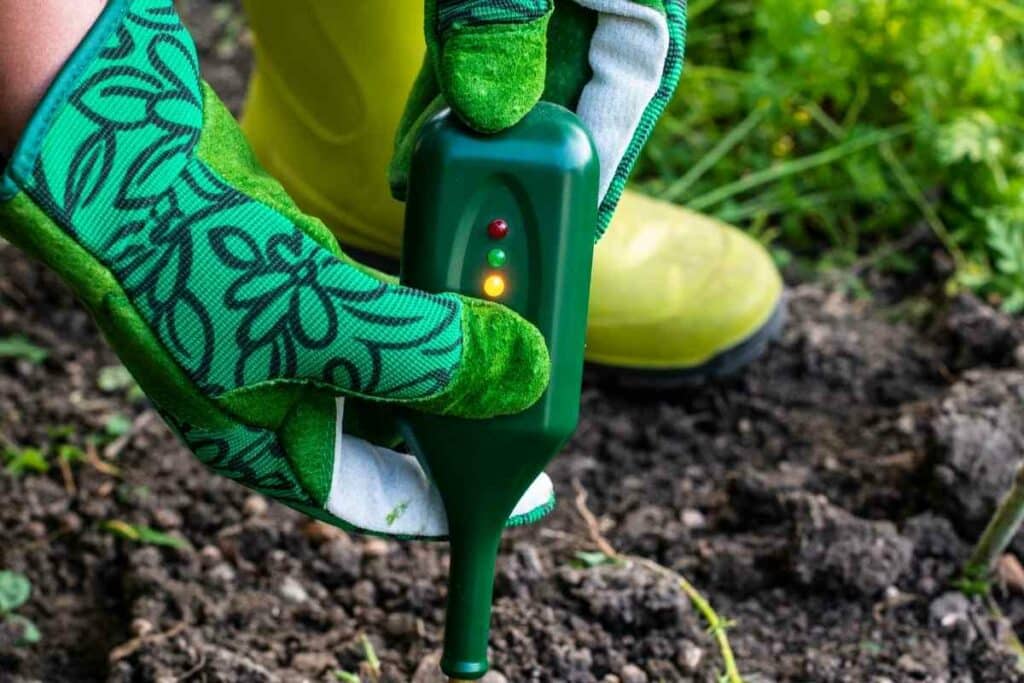Those with farms, vegetable gardens, or even indoor potted gardens know the importance of proper watering. You don’t want to overwater or cause your plants to go into drought.
Yet, knowing when to water can be an issue. Rainfall, irrigation systems all come into the equation.
That is why many farmers and backyard gardeners rely on soil motion sensors.
The sensors don’t tell you exactly how much water is in the soil but they monitor other changes in the soil that show that water is being used and the soil is going dry.

Numerous types of soil sensors are available and it pays to know the choices, how they function and how to interpret the readings.
In This Article: Below is a soil moisture sensor complete user guide to help those looking at buying a sensor understand what they are getting.
What Is a Soil Moisture Sensor?
A soil moisture sensor reports how much water content is in the oil and it can also be used to show how much water is stored in the soil.
Sensors must have contact with the soil to function.
Measuring the volume of water content in the soil is helpful to professional farmers who depend on scientific information for a successful harvest season.
It is also a great tool for those in soil, environmental and agricultural science doing experiments and is also used in horticulture, biology, and botany.
How are Soil Sensors Used?
Three ways exist on how soil sensors are used.
All three are examined in this soil moisture sensor complete users guide.
What Is Single-Point Measurement?
Single-point measurement is when the sensors are used to evaluate water tables in one single location with a certain depth.
The problem with this method is you must dig a large hole to install each sensor.
That can hurt plants and disturb the soil. Yet, a single sensor may be all you need for your land.
One sensor can provide water content measurements in a 600-meter diameter footprint.
What Is a Multi-point profile?
Multi-point profile measurement involves inserting multi-point probes with single-point sensors encased in one unit.
This allows for several points to be inserted at the same time.
Bad News: The downside is you have to use a power boring tool to insert the unit into the soil.
What Is Continuous Profile Management?
The third type of sensor is continuous profile management.
In this type of sensor, antennas are acting as sensors that provide measurement monitoring across the entire area, not just where the sensors are placed.
That provides a clear picture of a moisture profile.
This can typically be installed with a pilot rod but a boring tool may be needed in some cases.
Cost differences exist between the three types of soil moisture sensors and more money could be spent on installation, depending on how much work is involved in putting it in the ground.
Beyond the three basic types of soil moisture sensors, there are specific types of sensors that measure water in different ways.
Those include:
- Tension meters
- Gypsum blocks
- Capacitance
- Volumetric
- Neutron Probes
- State soil sensors
Each works differently by measuring different aspects of the soil and how it relates to water in the land.
Some measure the volume of water while others measure soil tension or electrical elements.
Are Soil Sensors Accurate?
Yes, agricultural researchers state sensors are accurate in measuring water in the soil, although they state a sensor with calibration specific to the soil being studied is far more accurate than using the factory calibration equations.
Extension offices recommend using a sensor with a neutron probe as it is believed to be the most accurate in measuring water in the soil, which is a volumetric sensor.
It measures hydrogen soil content, a good indication of water volume.
Volumetric sensors are simple to understand as they measure water content in the soil directly.
Besides neutron moisture probes, di-electric sensors and heat dissipation sensors also fall into this category. However, they still all work differently.
The di-electric sensors judge water content by an electrical element that depends on soil moisture while the heat dissipation sensor measures the heat compared to the surroundings.

Tensiometers work using the soil tension as a way to determine water. This device is a water-filled verticle tube inserted into specific soil depths.
It has a porous tip and the soil draws water out of the tube through the tip.
That creates a vacuum and the strength of the vacuum indicates how dry the soil is. A strong vacuum indicates drier soils.
Solid-state Sensors
Solid-state sensors include those like granular matric sensors and gypsum blocks.
They function by measuring electrical resistance in the soil using two electrodes.
Electrical resistance is reduced when there is more water.
The simplest types of sensors are the hygrometers that gauge soil moisture levels using moisture sensors.
They may use a color-coded scale from 1 to 10, a percentage, or a decimal number to indicate moisture rankings.
Even Better: These types of sensors are awesome devices for beginning gardeners as they are easy to use.
Other Functions of a Soil Moisture Sensor
Some soil moisture sensors do other things besides measure water in the soil.

There are moisture sensors that also measure pH levels, light levels, and even temperature.
Devices that also measure pH levels with soil sensors can tell you whether the soil is alkaline or acidic. That could help you choose additives for it or decide what plants will grow the best.
Some soil moisture sensors will also pick up on other necessary nutrients that are missing from the soil. That helps you pick the additives to put into the land.
Understanding light levels will help you pick plants that grow best in certain types of light.
This feature measures how intense the light is in a specific area. You may need several to measure a wider space as light shifts and moves.
There are soil moisture meters that also report the surrounding temperature. This helps someone growing a garden or outdoor plants to know when the season is about the change.
That can show a gardener when is the best time to plant things like tulips or daffodils or prune back bushes or trees.
How Are Readings From a Soil Sensor Interpreted?
The standard interpretations of a soil moisture sensor range from 0 to 100 CB (kPA).
Lower numbers indicate a more saturated soil while high numbers indicate normal water volume in soils needing irrigation.
For instance, 0-10 shows saturated soil while 60-100 is the typical water range showing heavy clay soils needing irrigation.
Normally, the optimum soil moisture level is between 10 and 18 percent.
The displays on the different sensors can be either manual and digital displays. It depends on the brand and model of the meter.
Most suggest seeking out a meter that is easy to see.
How Much Does a Soil Sensor Cost?
Quality soil moisture sensors cost between $100 and $1,000 with the volumetric sensors being the most expensive.
The tensiometers fall to the lower end of the price scale and solid-state sensors are the least expensive with some costing a little as $35.
Some people can make their own but that requires some technical skill to get an accurate reading.
It also takes a few supplies, like probes or electrodes.
In The End: You may spend more money on parts to build one than it would cost to buy a sensor, especially looking at the less expensive ones.
How to Choose the Best Soil Moisture Sensor
The type of meter you look for depends on how you plan to use it.
There are ones that are good for outdoor use and those that are good for indoor use. There are some made for both outdoor and indoor use.
Overall:
- You want one that is durable and that provides detailed information.
- You want one that displays well and works on a variety of soil types.
- Getting one that has “smart” features would also be a plus.
Indoor use meters will have a shorter probe.
Outdoor use will require more durability in your sensor. It would also require a probe that is a minimum of 1/4-inch thick so it wouldn’t bend.
You will want a stainless steel probe rather than plastic and it needs to be longer than the ones for indoor use.
Accuracy
Long probes tend to be more accurate and are especially helpful in spaces where the soil runs deep or where plants have deep roots.

Even the short-probed devices are reasonably accurate.
The best way to measure accuracy is to take note of reasons pretty often.
Those that are consistent will show more accuracy. Sensors that have wild readings all over the map are proving they are less accurate.
Digital or Analog
You will need to choose between analog or digital sensors.
Analog sensors are typically cheaper and work well for home use. The codes and readings are easy to see and understand.
They don’t have batteries and can be used immediately as they are simple to install.
A range of features can be found on digital moisture meters but they are pricey.
These meters are also more accurate and have connective capabilities so it may be worth the extra convenience.
However, they require batteries and some require WiFi for their connectivity.
Some of these smart devices can be paired with your phone so you can review and manage your water needs from your phone.
That can prove helpful if you are traveling or going away on vacation.
Smart Meters
There are smart meters that link to Bluetooth so findings can be shown by an app on your phone. Tons of extra features exist on these devices.
You can track a plant’s growth and your device can tailor its advice on how to help each plant thrive.
The type of soil you have could influence your decision on which meter to buy.
Denser soil, like the ones that contain a lot of clay, will require a study probe that can dig into harder soils.
Most sensors will work well with indoor potting soil since it’s looser.
It may also be helpful to test the soil before you spend money on devices like soil moisture sensors. There are some cases where water isn’t the problem but an element like sodium is.
Plants may not do well if there is an off in the pH or other elements like sodium.
Focus on This: Understanding your soil content will help you pick the right type of moisture sensor.
Calibration
You will also need a meter that is easy to calibrate for different soils.
A user-calibrated device allows you to manually adjust it for various conditions and use so you get the ideal moisture needs of particular plants.

These calibrations will adjust for composting or gardening, and humidity.
Calibration allows for more accuracy with your device no matter how you are using it.
Getting specific measurements based on how an area is functioning with calibration will help you address concerns unique to that area.
You may also want a soil moisture sensor the whole family can use.
This could be a great way to teach kids about planting. Some sensors are designed for kids to be able to use and read the moisture levels.
These are inexpensive and don’t require batteries.
How Long Do Soil Moisture Sensors Last?
It depends on the brand and whether you use them inside or outside but most sensors will last for three to five years.
Those used inside will last longer than those outside because of how weather and climate affect them over time.
Conclusion
A soil sensor is useful for both amateur and professional gardeners and farmers because it helps you manage irrigation better.
It takes the guesswork out of when to irrigate your garden and some meters provide other information that makes gardening easier and more successful.
Many brands offer different functions and aren’t complicated to use as well as the highly-commercial devices that professionals in the agriculture industry use.
Understanding what you need and how these devices work with this soil moisture sensor complete users guide will help you make the right decision.


